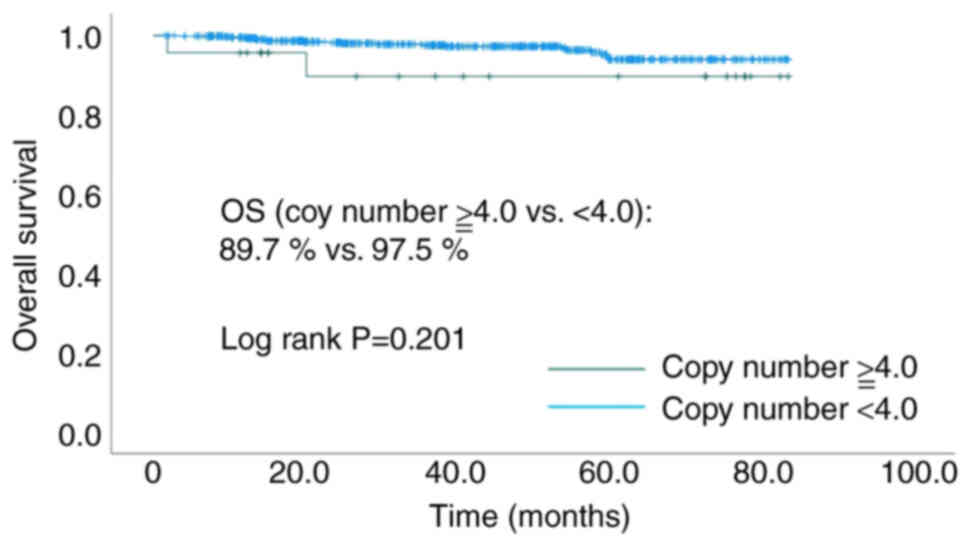|
1
|
Ross JS, Fletcher JA, Linette GP, Stec J,
Clark E, Ayers M, Symmans WF, Pusztai L and Bloom KJ: The Her-2/neu
gene and protein in breast cancer 2003: Biomarker and target of
therapy. Oncologist. 8:307–325. 2003. View Article : Google Scholar : PubMed/NCBI
|
|
2
|
Grant S, Qiao L and Dant P: Roles of ERBB
family receptor tyrosine kinases, and downstream signaling
pathways, in the control of cell growth and survival. Front Biosci.
7:d376–d389. 2002. View
Article : Google Scholar : PubMed/NCBI
|
|
3
|
Zhang H, Katerji H, Turner BM and Hicks
DG: HER2-low breast cancers: New opportunities and challenges. Am J
Clin Pathol. 157:328–336. 2022. View Article : Google Scholar : PubMed/NCBI
|
|
4
|
Slamon DJ, Clark GM, Wong SG, Levin WJ,
Ullrich A and McGuire WL: Human breast cancer: Correlation of
relapse and survival with amplification of the HER-2/neu oncogene.
Science. 235:177–182. 1987. View Article : Google Scholar : PubMed/NCBI
|
|
5
|
Romond EH, Perez EA, Bryant J, Suman VJ,
Geyer CE Jr, Davidson NE, Tan-Chiu E, Martino S, Paik S, Kaufman
PA, et al: Trastuzumab plus adjuvant chemotherapy for operable
HER2-positive breast cancer. N Engl J Med. 353:1673–1684. 2005.
View Article : Google Scholar : PubMed/NCBI
|
|
6
|
Paik S, Kim C and Wolmark N: HER2 status
and benefit from adjuvant trastuzumab in breast cancer. N Engl J
Med. 358:1409–1411. 2008. View Article : Google Scholar : PubMed/NCBI
|
|
7
|
Fehrenbacher L, Cecchini RS, Geyer CE Jr,
Rastogi P, Costantino JP, Atkins JN, Crown JP, Polikoff J, Boileau
JF, Provencher L, et al: NSABP B-47/NRG oncology phase III
randomized trial comparing adjuvant chemotherapy with or without
trastuzumab in high-risk invasive breast cancer negative for HER2
by FISH and with IHC 1+ or 2. J Clin Oncol. 38:444–453. 2020.
View Article : Google Scholar : PubMed/NCBI
|
|
8
|
Ergun Y, Ucar G and Akagunduz B:
Comparison of HER2-zero and HER2-low in terms of
clinicopathological factors and survival in early-stage breast
cancer: A systematic review and meta-analysis. Cancer Treat Rev.
115:1025382023. View Article : Google Scholar : PubMed/NCBI
|
|
9
|
Tarantino P, Hamilton E, Tolaney SM,
Cortes J, Morganti S, Ferraro E, Marra A, Viale G, Trapani D,
Cardoso F, et al: HER2-low breast cancer: Pathological and clinical
landscape. J Clin Oncol. 38:1951–1962. 2020. View Article : Google Scholar : PubMed/NCBI
|
|
10
|
Tarantino P, Jin Q, Tayob N, Jeselsohn RM,
Schnitt SJ, Vincuilla J, Parker T, Tyekucheva S, Li T, Lin NU, et
al: Prognostic and biologic significance of ERBB2-low expression in
early-stage breast cancer. JAMA Oncol. 8:1177–1183. 2022.PubMed/NCBI
|
|
11
|
Gampenrieder SP, Rinnerthaler G, Tinchon
C, Petzer A, Balic M, Heibl S, Schmitt C, Zabernigg AF, Egle D,
Sandholzer M, et al: Landscape of HER2-low metastatic breast cancer
(MBC): Results from the Austrian AGMT_MBC-registry. Breast Cancer
Res. 23:1122021. View Article : Google Scholar : PubMed/NCBI
|
|
12
|
Miglietta F, Griguolo G, Bottosso M,
Giarratano T, Lo Mele M, Fassan M, Cacciatore M, Genovesi E, De
Bartolo D, Vernaci G, et al: HER2-low-positive breast cancer:
Evolution from primary tumor to residual disease after neoadjuvant
treatment. NPJ Breast Cancer. 8:662022. View Article : Google Scholar : PubMed/NCBI
|
|
13
|
Schettini F, Chic N, Brasó-Maristany F,
Paré L, Pascual T, Conte B, Martínez-Sáez O, Adamo B, Vidal M,
Barnadas E, et al: Clinical, pathological, and PAM50 gene
expression features of HER2-low breast cancer. NPJ Breast Cancer.
7:12021. View Article : Google Scholar : PubMed/NCBI
|
|
14
|
Tarantino P, Niman S, Erick T, Priedigkeit
N, Harrison BT, Giordano A, Nakhlis F, Bellon JR, Parker T, Strauss
S, et al: HER2-low inflammatory breast cancer: Clinicopathologic
features and prognostic implications. Eur J Cancer. 174:277–286.
2022. View Article : Google Scholar : PubMed/NCBI
|
|
15
|
Horisawa N, Adachi Y, Takatsuka D, Nozawa
K, Endo Y, Ozaki Y, Sugino K, Kataoka A, Kotani H, Yoshimura A, et
al: The frequency of low HER2 expression in breast cancer and a
comparison of prognosis between patients with HER2-low and
HER2-negative breast cancer by HR status. Breast Cancer.
29:234–241. 2022. View Article : Google Scholar : PubMed/NCBI
|
|
16
|
Agostinetto E, Rediti M, Fimereli D,
Debien V, Piccart M, Aftimos P, Sotiriou C and de Azambuja E:
HER2-low breast cancer: Molecular characteristics and prognosis.
Cancers (Basel). 13:28242021. View Article : Google Scholar : PubMed/NCBI
|
|
17
|
Mouabbi J, Singareeka Raghavendra A,
Bassett R Jr, Hassan A, Tripathy D and Layman RM: Survival outcomes
in patients with hormone receptor-positive metastatic breast cancer
with low or no ERBB2 expression treated with targeted therapies
plus endocrine therapy. JAMA Netw Open. 6:e23130172023. View Article : Google Scholar : PubMed/NCBI
|
|
18
|
Park WK, Nam SJ, Kim SW, Lee JE, Yu J, Lee
SK, Ryu JM and Chae BJ: The prognostic impact of HER2-low and
menopausal status in triple-negative breast cancer. Cancers
(Basel). 16:25662024. View Article : Google Scholar : PubMed/NCBI
|
|
19
|
Denkert C, Seither F, Schneeweiss A, Link
T, Blohmer JU, Just M, Wimberger P, Forberger A, Tesch H, Jackisch
C, et al: Clinical and molecular characteristics of
HER2-low-positive breast cancer: Pooled analysis of individual
patient data from four prospective, neoadjuvant clinical trials.
Lancet Oncol. 22:1151–1161. 2021. View Article : Google Scholar : PubMed/NCBI
|














